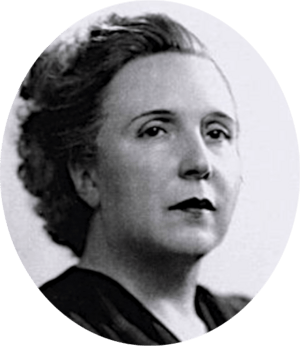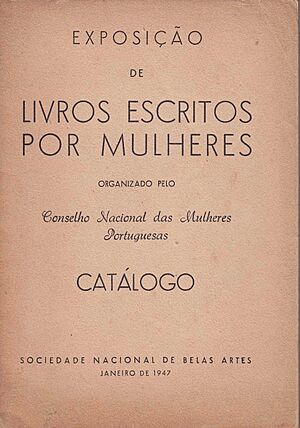Maria Lamas facts for kids
Quick facts for kids
Maria Lamas
|
|
|---|---|
 |
|
| Born |
Maria da Conceição Vassalo e Silva
6 October 1893 Torres Novas, Portugal
|
| Died | 6 December 1983 (aged 90) Lisbon, Portugal
|
| Nationality | Portuguese |
| Occupation | Author |
| Known for | Writer; Feminist; Opponent of authoritarian Estado Novo Government; Political prisoner |
|
Notable work
|
As Mulheres do Meu País; A Mulher no Mundo |
Maria Lamas (born October 6, 1893 – died December 6, 1983) was an important Portuguese writer, translator, and journalist. She was also a strong activist for women's rights and a brave opponent of the strict government of her time.
Contents
Early Life and Family
Maria da Conceição Vassalo e Silva da Cunha Lamas was born in Torres Novas, Portugal, on October 6, 1893. Her parents came from good families. She had two younger sisters and a brother, Manuel António Vassalo e Silva, who later became the last Governor of Portuguese India. She was also a cousin to children's book writers Alice Vieira and Maria Lúcia Vassalo Namorado.
Maria went to primary and secondary school in Torres Novas. She finished her secondary education at a boarding school run by Spanish nuns. Her father took her out of the school because he was worried she might want to become a nun.
In 1911, at age 17, she married Teófilo José Pignolet Ribeiro da Fonseca, a military officer. Soon after, she moved with him to Portuguese Angola, where her first daughter was born.
In 1913, Maria Lamas returned to Portugal. Her marriage was ending, and her husband was sent to fight in the First World War. She needed to support herself and her daughters. She moved to Lisbon and started working at the American News Agency. She also wrote for newspapers like Correio da Manhã.
She divorced in 1920 and married journalist Alfredo da Cunha Lamas in 1921. They had a daughter but separated soon after. They officially divorced in 1936, but Maria always kept her second husband's last name, Lamas.
Maria Lamas's Career and Activism
After her second marriage, Maria Lamas began writing for more newspapers, such as O Século and A Capital. She also published poetry, novels, and stories for children. Her writings for women often focused on improving women's rights.
In 1928, she was asked to lead a special section of O Século called Modas & Bordados. She made this section very popular by writing in a way that spoke directly to women. She questioned the old-fashioned ideas about women in Portuguese society. In 1936, she also created Joaninha, a special magazine for girls.
Maria became friends with other female writers in Portugal, like Branca de Gonta Colaço. In 1936, she joined the National Council of Portuguese Women (CNMP). This group was led by the feminist activist Adelaide Cabete.
Maria Lamas had a close friendship with the writer José Maria Ferreira de Castro. They wrote many letters to each other, sharing their daily lives and thoughts. They hoped these letters would be published after they died.
In 1930, Maria helped organize an "Exhibition of Female Work" with the CNMP and O Século. This exhibition showed off the work of women from all over Portugal, including their writing, art, and scientific achievements. It helped make women's work more visible. Because of her efforts, she was elected President for Education in the CNMP in 1937 and for Literature in 1939.
On February 7, 1934, she received an honor called the Order of Santiago for her work helping women. A year later, she joined the Associação Feminina Portuguesa para a Paz (Portuguese Women's Peace Association - AFPP). Here, she met another feminist and activist against the government, Virgínia Moura. From this time on, she started signing her work as Maria Lamas. Before, she used pen names like "Serrana d'Ayre" and "Vagna Ina."
In July 1945, Maria became president of the CNMP. She promised to start programs to help people learn to read and write across the country. She left her job at O Século to work on one of her most important books, The Women of my Country (As Mulheres do Meu País). This was the first report ever written about how women lived in Portugal.
In 1947, she also organized an exhibition of books written by women. It featured three thousand books by 1400 women authors from thirty countries. However, soon after, the CNMP was banned by the strict government of the Estado Novo.
In 1952, she published a two-volume work called The Woman in the World (A Mulher no Mundo). This book compared the state of feminism around the world. Both The Women of my Country and The Woman in the World faced censorship, meaning parts of them were removed by the government.
Maria Lamas also spoke out against the Estado Novo government. She supported José Norton de Matos when he tried to run for president in 1949. She was active in the Movement of Democratic Unity (MUD), a group that opposed the government. Because of her actions, she was arrested several times and held in the Caxias prison near Lisbon (in 1949, 1953, and 1962). In 1949, she was kept alone for several months and became very ill.
In 1962, tired of the constant threat of arrest, she moved to Paris, France. There, she met the writer Marguerite Yourcenar and translated one of her books. She also helped Portuguese people who were against the government, like Helena Pato and Stella Piteira Santos. She returned to Portugal at the end of 1969, after being promised she would not be arrested. For a time, she was also sent away to live on the Portuguese island of Madeira.
After the Carnation Revolution
On April 25, 1974, the Estado Novo government was overthrown by the Carnation Revolution. After this, Maria Lamas officially joined the Portuguese Communist Party. She also received many honors. She became a director of the Portuguese Committee for Peace and Cooperation and an honorary president of the Democratic Women's Movement in 1975. In 1978, she became a director of the publication Mulheres.
She received the Order of Liberty in 1980 and was honored by the Assembleia da República in 1982. In 1983, she received the Eugénie Cotton medal from the Women's International Democratic Federation (FDIM). Maria Lamas had helped start this Federation back in 1946.
Maria Lamas passed away in Lisbon on December 6, 1983, at the age of 90. In her hometown of Torres Novas, an industrial school was named after her in 1989. A small square was also named after her in 1987. Her name has also been given to several other roads and squares in Portugal.
Published Works
- Humildes (poetry) (1923)
- Diferença de Raças (novel) (1924)
- O Caminho Luminoso (novel) (1928)
- Maria Cotovia (children's book) (1929)
- As Aventuras de Cinco Irmãozinhos (children's book) (1931)
- A Montanha Maravilhosa (children's book) (1933)
- A Estrela do Norte (children's book) (1934)
- Brincos de Cereja (children's book) (1935)
- Para Além do Amor (novel) (1935)
- A Ilha Verde (children's book) (1938)
- O Vale dos Encantos (children's book) (1942)
- O Caminho Luminoso (1942)
- As Mulheres do Meu País (1948)
- A Mulher no Mundo (1952)
- O Mundo dos Deuses e dos Heróis, Mitologia Geral (1961)
- Arquipélago da Madeira (1956)
See also
- Archives of Maria Lamas at the Biblioteca Nacional de Portugal
 In Spanish: Maria Lamas para niños
In Spanish: Maria Lamas para niños


